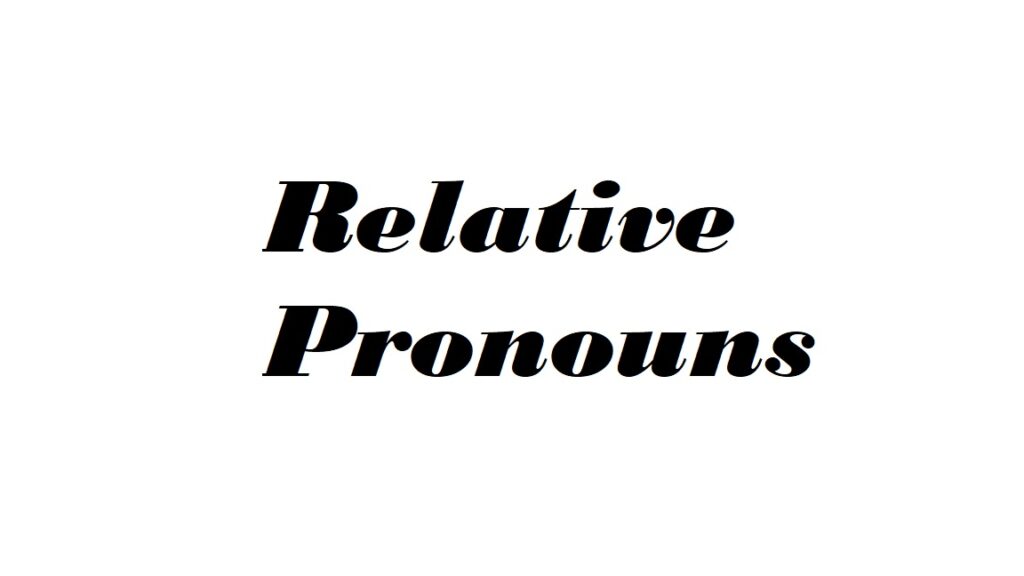Relative pronouns in ACT, Digital SAT, or EST are crucial and used in many questions, such as modifiers, restrictive, non restrictive, etc…, but what are relative pronouns in ACT, Digital SAT, or ESt? Relative pronouns are words used to link two clauses together.
common relative pronouns in ACT, Digital SAT, EST include:
Who – used for people (“The girl who won the race”)
Whom – used for people, more formal (“The man to whom I spoke”) (object Pronoun)
Which – used for things and animals (“The book which is on the table”)
That – used for people, things, and animals (“The car that I bought”)
Whose – shows possession (“The boy whose bike was stolen”)
Where – refers to a place (“The house where I grew up”)
When – refers to a time (“The day when we met”)
Find out “That” various usages.
These pronouns help to avoid repetition and make sentences more concise and easier to understand.
Relative clauses can be broadly categorized into restrictive (defining) and non-restrictive (non-defining) clauses. Here’s a breakdown of the differences between these two types of relative clauses:
Restrictive clauses ACT, Digital SAT, EST
Restrictive Clauses:
Definition: Restrictive clauses provide essential information about the noun they are modifying. They restrict or define the noun, clarifying which specific entity is being referred to.
Use of Relative Pronoun: The relative pronoun is necessary to the meaning of the sentence.
Punctuation: No commas are used to set off restrictive clauses.
Example: “The book that is on the table is mine.” (Here, the relative clause “that is on the table” restricts the noun “book” to a specific one.)
Non restrictive clauses ACT, Digital SAT, EST
Definition: Non-restrictive clauses provide additional, non-essential information about the noun they describe. They do not limit the meaning of the noun.
Use of Relative Pronoun: The relative pronoun is used to introduce the clause but can be omitted without changing the core meaning of the sentence.
Punctuation: Non-restrictive clauses are set off by commas in writing.
Example: “My sister, who is a doctor, lives in New York.” (Here, the relative clause “who is a doctor” adds extra information about the sister but is not essential to identifying her.) Understanding the distinction between restrictive and non-restrictive relative clauses is crucial for conveying precise meanings in writing and speaking. It helps in providing clarity and ensuring that the intended information is effectively communicated to the audience.
Restrictive VS non Restrictive clauses in ACT, SAT, EST
Relative Pronouns in Non-Restrictive Clauses:
In non-restrictive clauses, the relative pronoun can be replaced by “which” for things or animals, and “who” for people.
Example: “The book, which is on the table, is mine.” or “Mary, who is my friend, likes to read.”
Position of Non-Restrictive Clauses:
Non-restrictive clauses can often be placed within a sentence without altering its core meaning.
Example: “John, who is the CEO, will be at the meeting.”
Intonation in Speaking:
In spoken language, non-restrictive relative clauses are often pronounced with a different intonation to indicate that the information is additional.
Example: “My sister, who is a doctor, lives in New York.”
Relative pronouns in Formal writing ACT, EST, Digital SAT
In formal writing, non-restrictive relative clauses are set off by commas to clearly separate the additional information from the main clause.
Example: “The book, which I borrowed from the library, was very interesting.”
Avoiding Ambiguity:
Using restrictive and non-restrictive clauses appropriately helps to avoid ambiguity in sentences and ensures clarity in communication.
Example: “The man who is tall is my brother.” (Restrictive – implies there might be multiple men) vs. “The man, who is tall, is my brother.” (Non-restrictive – implies there is only one man)
Understanding how to use and differentiate between restrictive and non-restrictive relative clauses can refine your writing skills and help you convey information more effectively.
Omission relative pronoun in ACT, SAT, EST
In English, relative pronouns can sometimes be omitted in relative clauses if they are not the subject of the clause. This omission is more common in spoken English than in formal writing. Here are some points about the omission of relative pronouns:
Omission of Relative Pronouns:
Subject Pronouns:
When the relative pronoun is the subject of the relative clause, it is usually not omitted.
Example: “I saw the man who was walking down the street.”
Object Pronouns:
When the relative pronoun is the object of the verb in the relative clause, it can often be omitted.
Example: “I met the girl whom you were talking about.” (Can be written as “I met the girl you were talking about.”)
Preposition + Relative Pronoun:
When a preposition is involved, the relative pronoun is often retained.
Example: “This is the house in which I grew up.”
Informal vs. Formal:
Omitting the relative pronoun is more common in informal speech and writing.
Example: “The book that I read” can be informally spoken as “The book I read.”
Clarity:
While omitting relative pronouns can sometimes make sentences more concise, it’s essential to ensure that the meaning remains clear.
Example: “I like the car you bought.” (Omission of “that” in this case does not affect clarity.)
Mixed relative pronoun ACT,EST, Digital SAT
“Mixed relative pronouns” refer to a class of relative pronouns that combine elements of interrogative pronouns (question words) with relative pronouns. These pronouns are used to introduce relative clauses that describe a noun and ask a question at the same time. Common mixed relative pronouns include:
Whoever: Refers to any person who.
Example: “Give the package to whoever is at the door.”
Whomever: Refers to any person whom.
Example: “I will hire whomever I believe is the best fit for the job.”
Whatever: Refers to anything that.
Example: “I will accept whatever decision you make.”
Whichever: Refers to any one out of a group of things.
Example: “Choose whichever book you like.”
Whosever: Refers to anyone who possesses something.
Example: “I will return the wallet to whosever it belongs.”
Usage Guidelines:
Mixed relative pronouns combine the roles of asking a question and introducing a relative clause.
They can refer to people, things, or possessive relationships.
These pronouns are versatile and can be used in various contexts to provide additional information or ask questions about the antecedent.
Mastering the use of mixed relative pronouns can enhance the complexity and precision of your sentences, allowing you to convey nuanced meanings effectively.
Find us on Facebook
practice Digital SAT

